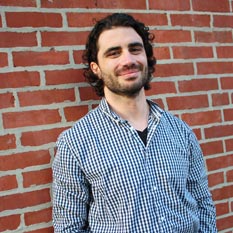
Jared McBride
Jared McBride, the first-ever Margee and Douglas Greenberg Research Fellow at the USC Shoah Foundation Center for Advanced Genocide Research, says testimony isn’t just an important aspect of his upcoming book manuscript. It can help prove that the controversial history he studies even happened.
McBride will conduct research for his dissertation and manuscript-in-progress “‘A Sea of Blood and Tears’: Collaboration and Resistance in Nazi-Occupied Volhynia, Ukraine 1941-1944.” It is a “bottom-up” social and political history of the Nazi occupation of the multi-ethnic Volhynia region in western Ukraine that probes the lives and experiences of average Volhynians. McBride focuses on resistance during the World War II period – not just within the Holocaust, but other overlapping episodes of violence.
McBride received his Ph.D. in history at UCLA. In 2015 he will begin a visiting assistant professorship in Columbia University’s history department.
As the Greenberg Research Fellow, Mc Bride will spend one week in residence at the USC Shoah Foundation conducting research in the Visual History Archive in January. He will also give a public talk about his work.
McBride was first introduced to the Visual History Archive at a 2008 conference in Paris about the Holocaust in Ukraine, where he met Visual History Archive curator Crispin Brooks. Brooks had read about McBride’s research and showed him some relevant testimonies at the conference, which proved very valuable to McBride’s work. McBride has since used around a dozen testimonies in his dissertation, including some survivors that he later met and re-interviewed himself.
He said visual testimony is an important part of his research methodology. He often integrates various sources, including archival documents and fieldwork, into his research, and has found that the testimonies in the Visual History Archive have layers of detail that he can use to verify and add to his other sources.
“We have a good picture of a lot of these people’s lives and who they were and what happened to them, but a lot of the local perpetrators who helped the Nazis, turning their neighbors in, these people always remain in the dark,” McBride said. “When I come in [to the USC Shoah Foundation] I’ll have a dozen towns in Volhynia I want to focus on in the testimonies to piece things together.”
The topic of mass violence in Volhynia during the Holocaust is often avoided by Ukrainian historians, McBride said, and his research is considered controversial in some circles. He feels testimony is critical to proving that these events did happen.
“Being able to back things up with testimony, triangulating sources, is a really big deal especially in these early phases when a lot of this new history is being written for Eastern Europe,” McBride said. “Showing, ‘Look, we have this information, we have this testimony, these people are telling the truth, and they deserve to be listened to,’ I think that’s really important. The fellowship is going to strengthen that component of my work.”
Although the Greenberg Fellowship will be his first time in residence at the USC Shoah Foundation Center for Advanced Genocide Research, McBride said he is an avid supporter of the Visual History Archive and frequently introduces it to his colleagues.
“I talk about the collection all the time because the things I’ve found have been really exciting,” McBride said.